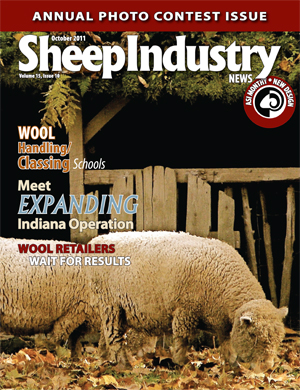Amy Trinidad
Sheep Industry News Editor
October 1, 2011) With the hot weather, lack of rain and devastating fires, many of the southern states continue to operate in severe drought conditions. Lack of forage and rising hay costs are moving a lot of breeding sheep to sale, particularly in New Mexico and Texas.
Drought conditions are not unusual for this part of the country; however, what sets this drought apart from those in the past according to Benny Cox, president of the Texas Sheep and Goat Raisers’ Association and sheep sales manager at Producers Livestock Auction in San Angelo, is this is the first time in drought-forced sales that sheep producers are seeing fair market price for their breeding stock.
“You really feel for the ranchers that are out of options for feeding stock; however, unlike some drought years when prices weaken due to forced sales, this year has very strong markets as well as areas with record hay and grass production plus producers looking to expand sheep numbers,” explains Peter Orwick, executive director of the American Sheep Industry Association.
Cox says he is seeing yearling and 2- to 3-year-old ewes being sold for $120 to $150 a head depending on body condition with some bunches of yearlings going for $180 per head. Detailing the surge in livestock sales this past summer, Cox says 53,077 more sheep and goats have moved through the ring from May through August this year than last year.
“Word has gotten out to the country that ewes are available for sale and the demand is out there, that’s positive,” he says.
One such producer looking to increase his flock, Ken Wixom, president of the Idaho Wool Growers Association, says he heard through the marketing channels that there was a mass liquidation of good ewes for sale in Texas.
“My heart goes out to those experiencing drought in the south but the positive part of this situation is that there are producers willing to buy these ewes and they aren’t ending up at slaughter,” says Wixom, who purchased 400 head from the drought-stricken area. “It’s hard to find replacements in Idaho and Montana so we saw this as an opportunity to expand.”
Breeding stock is not only moving north but a great deal have been sold to producers in the southeast part of the country. Bill Kuecker, the ASI director for the Tennessee Sheep Producers Association, says there is a sense of eagerness for those in the Southeast to either get into the sheep industry or increase their flock due to the economics of the industry and because of the available land resources.
“The advantage of multi-species grazing is being more publicized as of recent and producers are talking about its advantages,” he explains. “Because of that, people are looking to add sheep to their operations.”
As of the end of August, Kuecker had purchased 285 ewes out of Texas, which he says is a significant increase in production for his operation.
“We plan to retain 150 ewes and our friends and neighbors have expressed interest in purchasing the remaining ewes,” he explains about the opportunity to expand his flock with similar type of sheep. “Our hearts and prayers go out to those experiencing drought. It is a true tragedy but at least we are able to provide them with more value than going direct to slaughter.”
Not only is word being spread through the marketing channels that ewes are for sale, but producers are also turning to the internet whether it is to find hay to feed their livestock or advertise livestock that are for sale. For example, sheep can be found for sale due to drought on Craigslist and ASI has set up a page on its website, www.sheepusa.org/Drought_Assistance, to assist both producers selling or moving sheep and producers with available forage to lease or wanting to buy breeding sheep. Recently there have been posts with people looking to lease or cost-share ewes on available pasture in Washington, Arkansas and Wyoming.
In addition, information about the major sale barns in drought-ridden areas of the country is located on this page. This allows producers looking to sell or move sheep to make contact with other producers or auction barns that might be of assistance in buying or pasturing additional animals. To post to this page, emailjudym@sheepusa.org.
Explains Orwick about the development of the drought-assistance page, “Keeping the ewes in production from drought areas will help meet the production needs this year and help rebuild the flock after this record drought period.”


